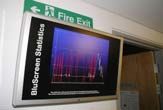'Minority Report' Ads Are In Your Future

BluScreen, an interactive advertising technology that identifies passers-by using their Bluetooth-enabled cellphones, is being tested at the school of Electronics and Computer Science at Southampton University in the UK.
At the school, the system will chose from different announcements about school events and scheduling. Once out in the real world, the system will present advertisements tailored to individuals.
The BluScreen system has a unique way of determining the ad shown; it holds a microsecond auction in which different advertisers can see the characteristics of the person and then bid on showing an ad. The "winner" of the auction selects the advertisement and pays accordingly.
Obviously, passers-by must have Bluetooth turned on, and profile information marked as available. Participants could influence ad content by the content of their profile.
Developers of the system are interested in having sensors in other parts of the building to build a profile of each individual, to better present them with information (ads) that are relevant to their recent experiences.
If you want to understand this in a more entertainment-oriented setting, take a look at the personalized graphic advertisements from the 2002 movie "Minority Report," directed by Steven Spielberg. The film, derived from the story "Minority Report" by science fiction writer Philip K. Dick, is set some years into the future. It also presents specific ads on screens to individuals after positive identification of the individual has been made.
It appears that the worldwide advertising machine is determined to implement this idea in real life. Another experiment similar to this one was conducted in France earlier this year; see French Billboards Call Your Cellphone for more information. For a look at other science-fictional technologies being implemented in the ad world, take a look at Ad Saturation Approaches 100 Percent. Find out more about BluScreen.
Sign up for the Live Science daily newsletter now
Get the world’s most fascinating discoveries delivered straight to your inbox.
(This Science Fiction in the News story used with permission from Technovelgy.com - where science meets fiction.)











